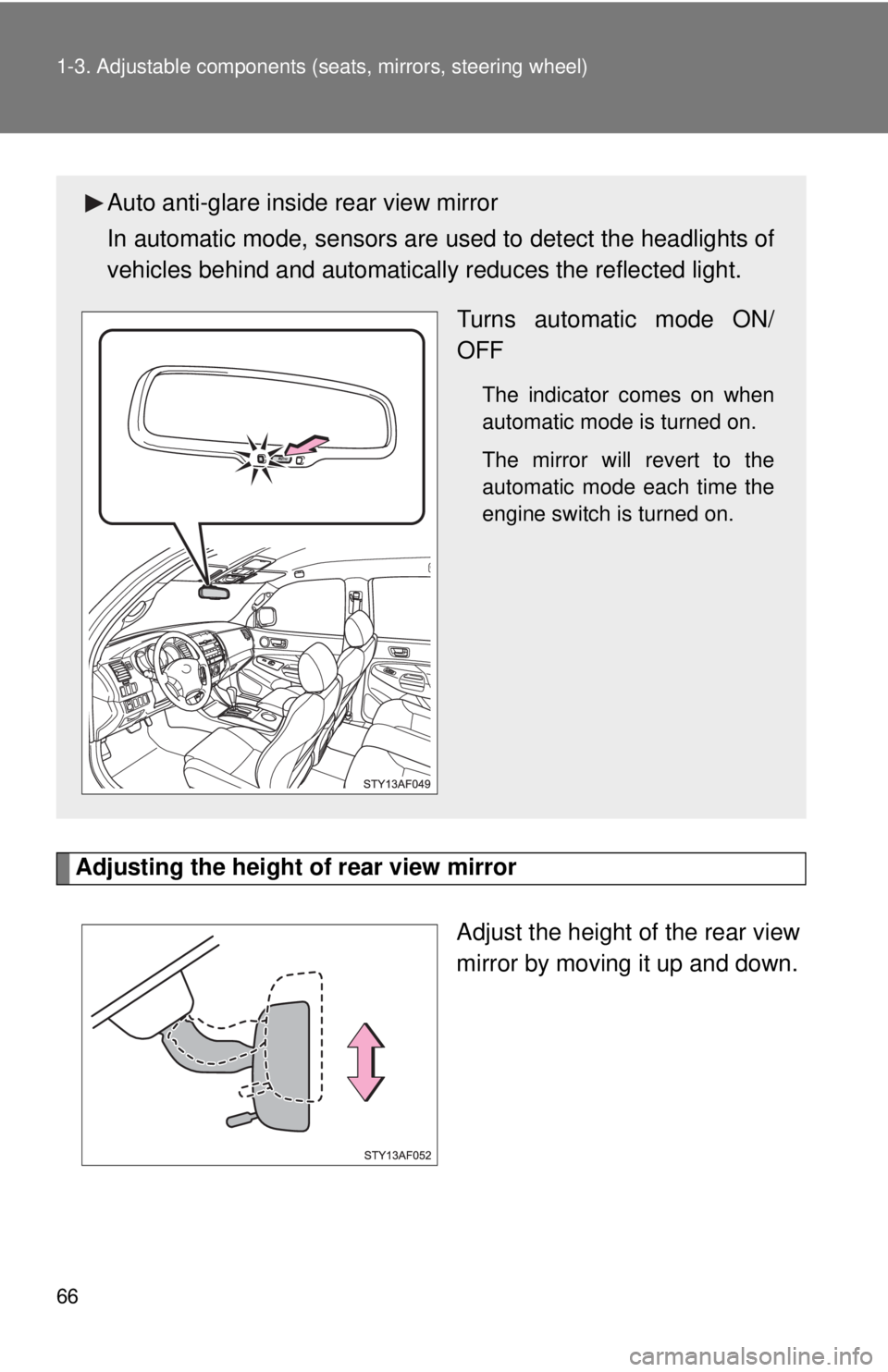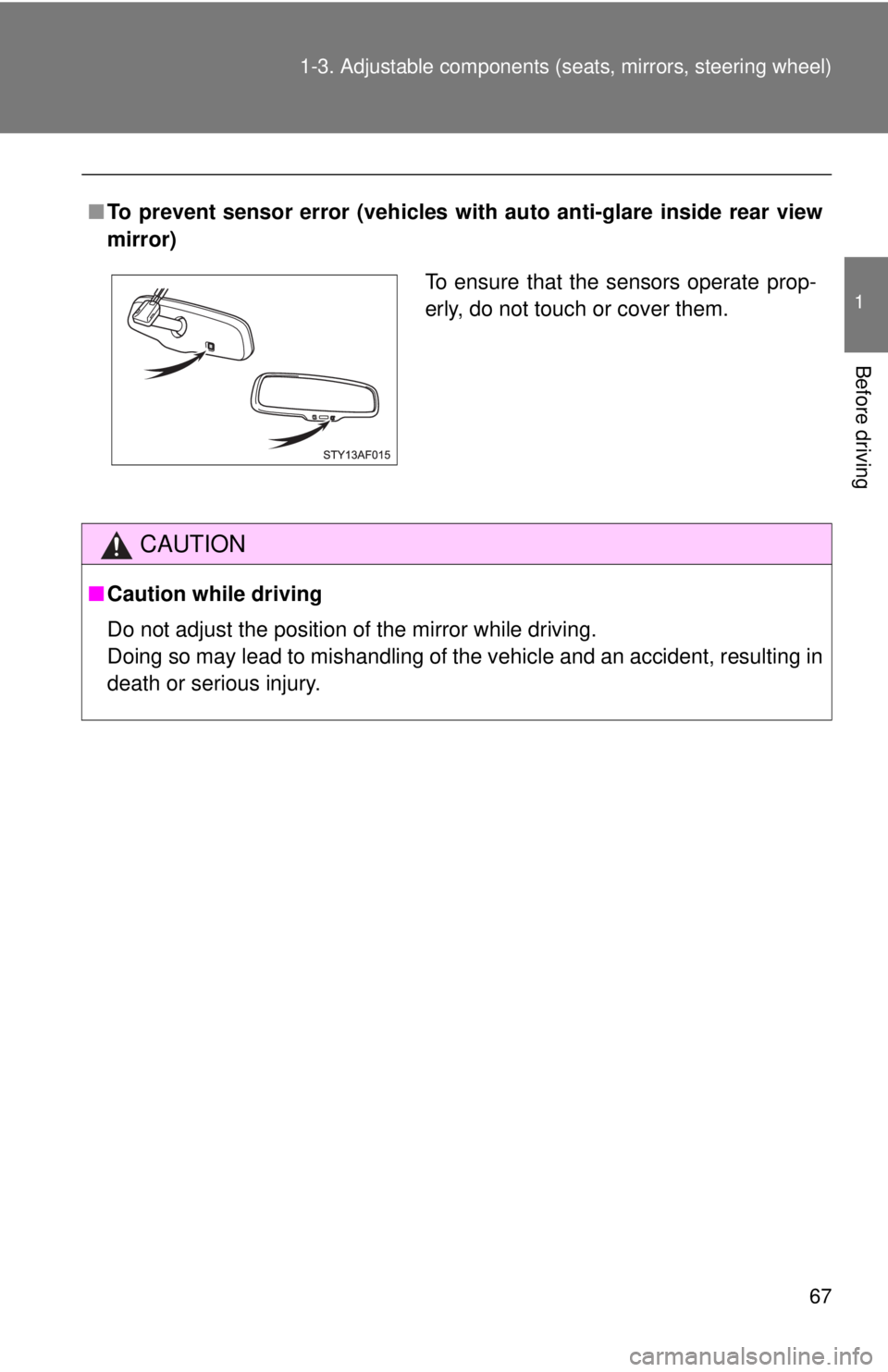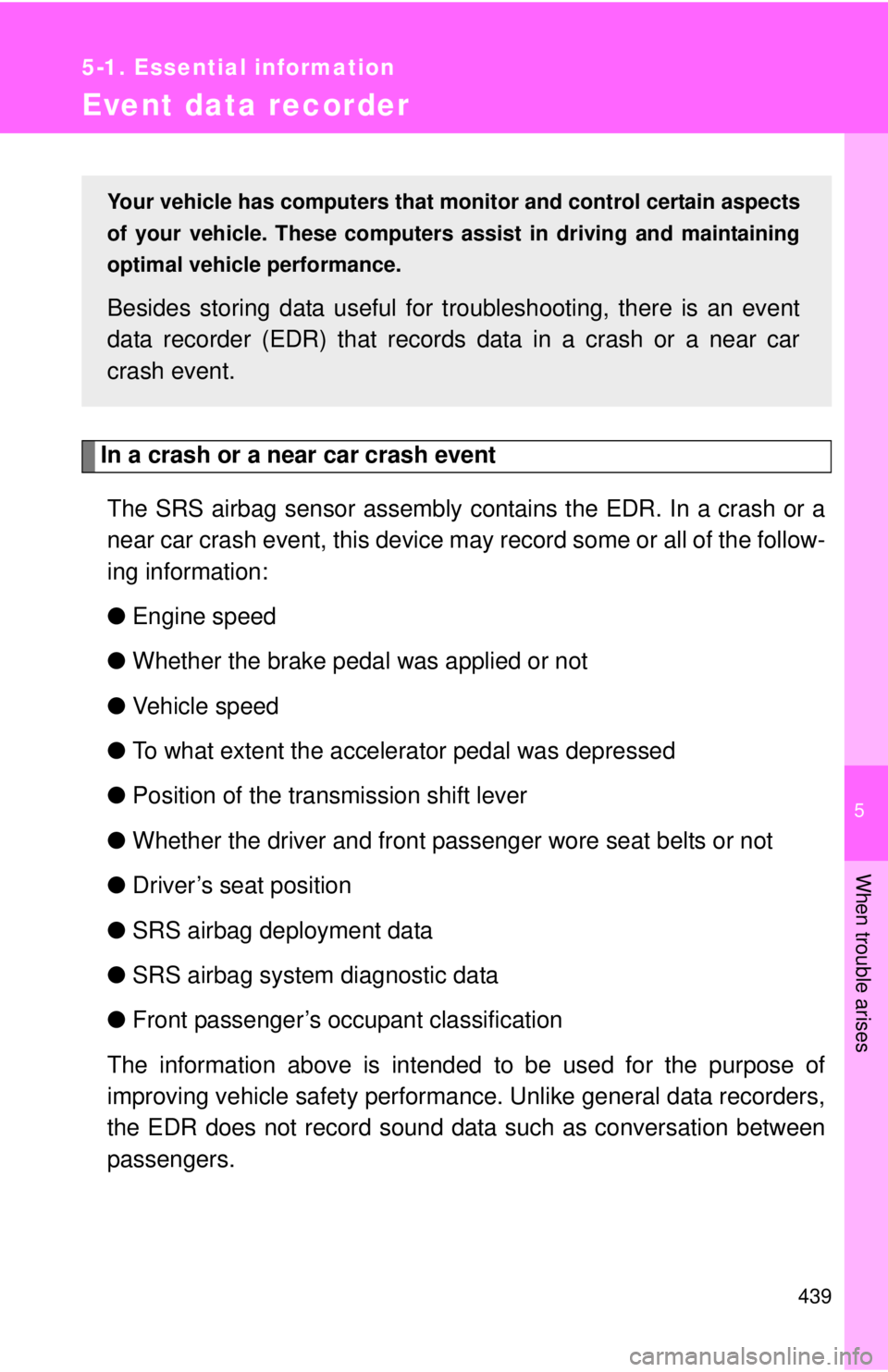sensor TOYOTA TACOMA 2011 Owners Manual (in English)
[x] Cancel search | Manufacturer: TOYOTA, Model Year: 2011, Model line: TACOMA, Model: TOYOTA TACOMA 2011Pages: 548, PDF Size: 9.86 MB
Page 62 of 548

62 1-3. Adjustable components (seats, mirrors, steering wheel)
CAUTION
■Adjustable shoulder anchor
Always make sure the shoulder belt is positioned across the center of your
shoulder. The belt should be kept away from your neck, but not falling off
your shoulder. Failure to do so could reduce the amount of protection in an
accident and cause death or serious injuries in the event of a sudden stop,
sudden swerve or accident. ( P. 59)
■ Seat belt pretensioners
●Do not place anything, such as a cushion, on the front passenger’s seat.
Doing so will disperse the passenger’s weight, which prevents the sensor
from detecting the passenger’s weight properly. As a result, the seat belt
pretensioner for the front passenger’s seat may not activate in the event of
a collision.
● If the pretensioner has activated, the SRS warning light will come on. In
that case, the seat belt cannot be used again and must be replaced at
your Toyota dealer.
■ Child restraint lock function belt precaution
Do not allow children to play with the child restraint lock function belt. If the
belt becomes twisted around a child’s neck, it will not be possible to pull the
belt out leading to chocking or other serious injuries that could result in
death. If this occurs and the buckle cannot be unfastened, scissors should
be used to cut the belt.
■ Seat belt damage and wear
●Do not damage the seat belts by allowing the belt, plate, or buckle to be
jammed in the door.
● Inspect the seat belt system periodically. Check for cuts, fraying, and loose
parts. Do not use a damaged seat belt until it is replaced. Damaged seat
belts cannot protect an occupant from death or serious injury.
● Ensure that the belt and tab are locked and the belt is not twisted.
If the seat belt does not function correctly, immediately contact your Toyota
dealer.
● Replace the seat assembly, including the belts, if your vehicle has been
involved in a serious accident, even if there is no obvious damage.
Page 66 of 548

66 1-3. Adjustable components (seats, mirrors, steering wheel)
Adjusting the height of rear view mirror
Adjust the height of the rear view
mirror by moving it up and down.
Auto anti-glare inside rear view mirror
In automatic mode, sensors are used to detect the headlights of
vehicles behind and automatical ly reduces the reflected light.
Turns automatic mode ON/
OFF
The indicator comes on when
automatic mode is turned on.
The mirror will revert to the
automatic mode each time the
engine switch is turned on.
Page 67 of 548

67
1-3. Adjustable components (s
eats, mirrors, steering wheel)
1
Before driving
■To prevent sensor error (vehicles with auto anti-glare inside rear view
mirror)
CAUTION
■ Caution while driving
Do not adjust the position of the mirror while driving.
Doing so may lead to mishandling of the vehicle and an accident, resulting in
death or serious injury.
To ensure that the sensors operate prop-
erly, do not touch or cover them.
Page 84 of 548

84 1-7. Safety information
Your vehicle is equipped with ADVANCED AIRBAGS designed based
on US motor vehicle safety standards (FMVSS208). The airbag sys-
tem controls airbag deployment power for the driver and right front
passenger. The driver airbag system consists of the driver seat’s
position sensor etc. The front pass enger’s airbag system consists of
the front passenger occupant classification sensor etc.
The main SRS airbag system components are shown above. The
SRS airbag system is controlled by the airbag sensor assembly. The
airbag sensor assembly consists of a safing sensor and an airbag
sensor.
Bench type front seat: The SRS airb ags are designed to protect the
driver and right front passenger, and they are not designed to protect
an occupant in the front center seating position. Front passenger airbag
Curtain shield airbags
Side airbags
AIR BAG ON and AIR BAG
OFF indicator lights
SRS warning light and
RSCA OFF indicator light
Driver airbag
RSCA OFF switch
(4WD models only)
Curtain shield airbag sen-
sors (Access Cab and Dou-
ble Cab models)
Side and curtain shield air-
bag sensors
Driver’s seat position sen-
sor
Driver’s seat belt buckle
switch
Front passenger’s seat belt
buckle switch
Occupant detection system
(ECU and sensors)
Airbag sensor assembly
Front airbag sensors
Front passenger’s seat
position sensor
Belt tension sensor
Passenger airbag off switch
(Access Cab models)
Page 85 of 548

85
1-7. Safety information
1
Before driving
In certain types of severe frontal or side impacts, the SRS airbag sys-
tem triggers the airbag inflators. A
chemical reaction in the inflators
quickly fills the airbags with non-toxic gas to help rest rain the motion
of the occupants.
■ SRS warning light
This warning light system monitors the airbag sensor assembly, front airbag
sensors, side and curtain shield airbag sensor assemblies, curtain shield air-
bag sensor assemblies (Access Cab and Double cab models), driver’s seat
position sensor, driver’s seat belt buckle switch, front passenger occupant
classification system, AIR BAG ON and AIR BAG OFF indicator lights, front
passenger’s seat position sensor (Bench type seat), front passenger’s seat
belt buckle switch, passenger airbag off switch (Access Cab models), front
seat belt pretensioner assemblies, belt tension sensor (Bench type seat),
RSCA OFF indicator light, inflators, interconnecting wiring and power
sources. ( P. 442)
■ If the SRS airbags deploy (inflate)
●Bruising and slight abrasions may result from contact with a deploying
(inflating) SRS airbag.
● A loud noise and white powder will be emitted.
● Parts of the airbag module (steering wheel hub, airbag cover and inflator)
as well as the front seats, and parts of the front and rear pillars and roof
side rail, may be hot for several minutes. The airbag itself may also be
hot.
● The front windshield may crack.
■ Operating conditions (front airbags)
●The SRS front airbag will deploy in the event of an impact that exceeds
the set threshold level (the level of force corresponding to an approxi-
mately 12-18 mph [20-30 km/h] frontal collision with a fixed wall that does
not move or deform).
However, this threshold velocity will be considerably higher if the vehicle
strikes an object, such as a parked vehicle or sign pole, which can move or
deform on impact, or if the vehicle is involved in an underride collision (e.g.
a collision in which the front of the vehicle “underrides”, or goes under, the
bed of a truck, etc.).
Page 351 of 548

351
3-6. Other interior features
3
Interior and exterior features
NOTICE
■
To avoid the compass malfunctions
Do not place magnets or any metal objects on or near the roof.
Doing this may cause a malfunction of the compass sensor.
■ To ensure normal operation of the compass
●Do not perform circling calibration of the compass in a place where the
earth’s magnetic field is subject to in terference by artificial magnetic fields.
● During calibration, do not operate electric systems (power windows, etc.)
as they may interfere with the calibration.
Page 439 of 548

5
When trouble arises
439
5-1. Essential information
Event data recorder
In a crash or a near car crash eventThe SRS airbag sensor assembly contains the EDR. In a crash or a
near car crash event, this device may record some or all of the follow-
ing information:
● Engine speed
● Whether the brake pedal was applied or not
● Vehicle speed
● To what extent the accelerator pedal was depressed
● Position of the transmission shift lever
● Whether the driver and front passenger wore seat belts or not
● Driver’s seat position
● SRS airbag deployment data
● SRS airbag system diagnostic data
● Front passenger’s occupant classification
The information above is intended to be used for the purpose of
improving vehicle safety performance. Unlike general data recorders,
the EDR does not record sound data such as conversation between
passengers.
Your vehicle has computers that monitor and control certain aspects
of your vehicle. These computers assi st in driving and maintaining
optimal vehicle performance.
Besides storing data useful for tr oubleshooting, there is an event
data recorder (EDR) that records data in a crash or a near car
crash event.
Page 446 of 548

446 5-2. Steps to take in an emergency
The light will go off after taking several driving trips.
If the light does not go off even after several trips, contact your Toyota dealer
as soon as possible.
■ Front passenger detect ion sensor and passenger seat belt reminder
If luggage or other load is placed on the front passenger seat, depending on
its weight, the reminder light to flash and buzzer to sound.
■
When the tire pressure warning light comes on
Check the tire inflation pressure and adjust to the appropriate level.
Pushing the tire pressure warning reset switch does not turn off the tire
pressure warning light.
■The tire pressure warning light ma y turn on due to natural causes
The tire pressure warning light may turn on due to natural causes such
as natural air leaks or tire inflation pressure changes caused by temper-
ature. In this case, adjusting the ti re inflation pressure will turn off the
warning light (after a few minutes).
■When a tire is replaced with a spare tire
The temporary spare tire is not equipped with the tire pressure warning
valve and transmitter. If a tire goes flat, the tire pressure warning light will
not turn off even though the flat tire is replaced with the temporary spare
tire. Replace the temporary spare tire with the repaired tire and adjust
the proper tire inflatio n pressure. The tire pres sure warning light will turn
off after a few minutes.
■If the tire pressure warning system is inoperative
The tire pressure warning system will be disabled in the following condi-
tions:
(When the condition becomes normal, the system will work properly.)
●If tires not equipped with tire pressure warning valves and transmit-
ters are used.
●If the ID code on the tire pressure warning valves and transmitters is
not registered in the tire pressure warning computer.
●If the tire inflation pressure is 73 psi (500 kPa, 5.1 kgf/cm2 or bar) or
higher.
Page 542 of 548

542 Alphabetical index
Tachometer............................... 157
TailgateRemoving the tailgate .............40
Tailgate ...................................40
Tail lights
Replacing light bulbs ............. 427
Switch.................................... 165
Talk switch................................ 281
Telephone switch ..................... 281
Theft deterrent system Engine immobilizer system .....78
Tire inflation pressure ............. 500
Tire information Glossary ................................ 512
Size ....................................... 509
Tire identification number ...... 508
Uniform tire quality grading ... 510
Tires Chains ................................... 211
Checking ............................... 388
If you have a flat tire .............. 450
Identification number ............. 508
Inflation pressure................... 500
Inflation pressure sensor ....... 389
Information ............................ 507
Replacing ...................... 388, 450
Rotating tires ......................... 388
Size ....................................... 500
Snow tires ............................. 210
Spare tire............................... 450
Tire pressure warning reset switch ......................... 389
Tire pressure warning system ........................ 388, 446
Warning light ......................... 444
Tools ......................................... 450
Total load capacity................... 208
Towing Bumper towing ...................... 223
Dinghy towing........................ 234
Emergency towing................. 431
Fifth wheel trailer ................... 221
Trailer towing......................... 214 Traction control ....................... 192
TRAC ......................................... 192
Trip meter ................................. 158
Turn signal lights
Lever ..................................... 153
Replacing light
bulbs ........................... 423, 424
Switch ................................... 153
Wattage................................. 503
Valet key ..................................... 30
Vanity mirrors .......................... 320
Vehicle identification number ................................... 489
Vehicle stability control .......... 192
VSC ........................................... 192
Warning buzzers Key reminder......................... 445
Brake system ........................ 441
Seat belt reminder................. 444
Warning lights ABS ....................................... 442
Airbag system ....................... 442
Anti-lock brake system .......... 442
Automatic transmission fluidtemperature ........................ 442
Brake system ........................ 441
Charging system .... ............... 442
Driver’s seat belt ................... 444
Electronic engine control
system ................................ 442
Engine oil replacement ......... 444
Front passenger occupant
classification system ........... 442
Front passenger’s seat belt... 444
Low brake fluid ...................... 441
Low engine oil pressure ........ 442
Low fuel level ........................ 444
Low tire inflation pressure ..... 444
Malfunction indicator lamp .... 442
Open door ............................. 444T
V
W